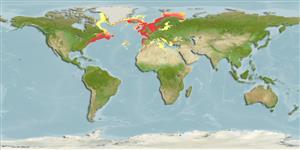>
Scombriformes (Mackerels) >
Scombridae (Mackerels, tunas, bonitos) > Scombrinae
Etymology: Scomber: Greek, skombros = tunny or mackerel, 1623 (Ref. 45335).
More on author: Linnaeus.
Environment: milieu / climate zone / intervalo de profundidade / distribution range
Ecologia
marinhas; estuarina pelagic-neritic; oceanódromo (Ref. 51243); intervalo de profundidade 0 - 1000 m (Ref. 54254), usually 0 - 200 m (Ref. 54254). Temperate; 75°N - 30°N, 77°W - 42°E
North Atlantic: including the Mediterranean.
Length at first maturity / Tamanho / Peso / Idade
Maturidade: Lm 28.7, range 34 - ? cm
Max length : 60.0 cm FL macho/indeterminado; (Ref. 35388); common length : 30.0 cm FL macho/indeterminado; (Ref. 168); peso máx. Publicado: 3.4 kg (Ref. 9988); Idade máx. registada: 17 anos (Ref. 207)
Espinhos dorsais (total) : 8 - 14; Raios dorsais moles (total) : 11 - 13; Espinhos anais: 1; Raios anais moles: 12 - 13; Vértebras: 31. This species has the following characters: no well developed corselet; interpelvic process small and single; anal fin spine conspicuous, joined to the fin by a membrane but clearly independent of it; anal fin origin opposite that of second dorsal fin; no swim bladder; first haemal spine anterior to first interneural process; 21-28 interneural bones under first dorsal fin; markings on back oblique to near vertical, with relatively little undulating; belly unmarked (Ref. 168).
Body shape (shape guide): fusiform / normal; Cross section: oval.
Abundant in cold and temperate shelf areas, forms large schools near the surface. They overwinter in deeper waters but move closer to shore in spring when water temperatures range between 11° and 14°C. Mainly diurnal, it feeds on zooplankton and small fish. Eggs and larvae are pelagic (Ref. 6769). Batch spawner (Ref. 51846). The species is traded fresh, frozen, smoked and canned. Eaten fried, broiled and baked (Ref. 9988). Two stocks in north-east Atlantic: North Sea (east) and British Isles (west). North Sea stock decreased dramatically in the 1960's because of direct overfishing. Recruitment has been poor and unstable. After spawning, the adult feed very actively moving around in small shoals (Ref. 35388).
Collette, B.B. and C.E. Nauen, 1983. FAO Species Catalogue. Vol. 2. Scombrids of the world. An annotated and illustrated catalogue of tunas, mackerels, bonitos and related species known to date. Rome: FAO. FAO Fish. Synop. 125(2):137 p. (Ref. 168)
Categoria na Lista Vermelha da IUCN (Ref. 130435: Version 2025-1)
Ameaça para o homem
Harmless
Utilização humana
Pescarias: altamente comercial; peixe desportivo: sim
Ferramentas
Relatórios especiais
Descarregue XML
Fontes da internet
Estimates based on models
Preferred temperature (Ref.
123201): 7 - 17.5, mean 10.2 °C (based on 2460 cells).
Phylogenetic diversity index (Ref.
82804): PD
50 = 0.5625 [Uniqueness, from 0.5 = low to 2.0 = high].
Bayesian length-weight: a=0.00646 (0.00585 - 0.00712), b=3.07 (3.04 - 3.10), in cm total length, based on LWR estimates for this species (Ref.
93245).
Nível Trófico (Ref.
69278): 3.6 ±0.2 se; based on diet studies.
Generation time: 3.1 (2.3 - 4.1) years. Estimated as median ln(3)/K based on 17
growth studies.
Resiliência (Ref.
120179): Médio, tempo mínimo de duplicação da população 1,4 - 4,4 anos (rm=0.33-0.56; K=0.23-0.27; tm=2-3; tmax=17; Fec=200,000).
Prior r = 0.43, 95% CL = 0.28 - 0.64, Based on 10 full stock assessments.
Fishing Vulnerability (Ref.
59153): Low to moderate vulnerability (30 of 100).
🛈
Climate Vulnerability (Ref.
125649): Low vulnerability (10 of 100).
🛈
Nutrients (Ref.
124155): Calcium = 20.1 [7.8, 49.4] mg/100g; Iron = 0.705 [0.260, 1.627] mg/100g; Protein = 20.5 [19.4, 21.8] %; Omega3 = 0.761 [0.515, 1.159] g/100g; Selenium = 52 [28, 97] μg/100g; VitaminA = 16.8 [5.0, 65.8] μg/100g; Zinc = 0.695 [0.445, 1.022] mg/100g (wet weight); based on
nutrient studies.
